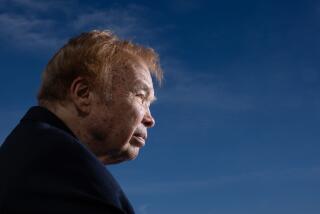Psychologists Tackle That Symbol of Terror--Schoolyard Bullies
- Share via
CAMBRIDGE, Mass. — Billy Wright was a mean 8-year-old, a bully through and through. He was the sort of kid who lorded over the playground, forcing weaker classmates into submission through force or threat.
His aggression was so unbridled that he even got into fights with his teacher.
Billy Wright is one of thousands of youngsters who through plain terror have held sway over their peers. Until recently, they have been largely ignored by the authorities.
Now, people like psychologist Robert Selman are taking notice.
Selman, an associate professor at Harvard’s Graduate School of Education and its Medical School, treated Billy Wright (not his real name) for two years. He thinks that he helped Billy and that other bullies, whose problems often can be traced to troubled family lives, also can be helped.
No ‘Natural Bullies’
“While there are naturally assertive and dominant personalities, I don’t think there are natural bullies,” said Selman, who has dealt with extreme cases. “If one has been bullied by adults, it becomes a style one picks up.”
Harvard psychologist Ronald G. Slaby, 42, a colleague of Selman’s who also has studied bullies, agrees. He said new research has found that interaction between family members and between classmates, as well as social conditions in the neighborhood, greatly contributes to aggressive habits.
Some otherwise normal children become bullies when they see coercion pay off, Slaby said. And boys show higher levels of both verbal and physical aggression than girls because adults may tolerate, even encourage, such behavior as part of the traditional masculine image.
There are also groups of bullies.
Special Program
At Boston’s English High School a few years ago, bullying took the form of black Americans intimidating students of Haitian descent until school authorities stepped in with a special program to address the problem, said Lavaughn Chapman, assistant headmaster.
Now the bullying has taken a more individual character, such as kids forcing others from their school-bus seats, he said. The inner city school deals with the problem with a warning or a suspension, followed by counseling by Harvard doctoral candidates in psychology.
“We have found that we can deter bullies by monitoring their progress,” Chapman said. Acute cases are referred to school system psychologists.
Elsewhere, considerable research has been undertaken in Scandinavia and the Japanese recently surprised academics by expressing grave concern about their own brand of schoolyard thugs.
Culture Conflict
“It’s a phenomenon in many countries,” said Gerald Lesser, a Harvard professor of education, who recently returned from a four-month visit to Japan. “Bullies are receiving a lot of attention in Japan because they’re not consistent with Japanese culture, which is to treat each other with courtesy and kindness.”
The Norwegian government considers it a major social problem and has asked a leading authority on bullies, psychologist Dan Olweus, to set up a national school program to deal with the aggressors, said Gerald Patterson, a research scientist at the Oregon Social Learning Center in Eugene, Ore.
Patterson said that 10 years of research by Olweus in Sweden and elsewhere has shown that both bullies and their victims retain their patterns of behavior for at least two years.
“A bully finds it very reinforcing to inflict pain on other people and then get submissive reactions,” he said in a telephone interview. “And I think there are adults like that as well as children. You can go into a bar or into an Army unit and find the same things.”
‘Quite Socially Skilled’
But unlike antisocial pre-adolescents, whom Patterson has studied for the last 20 years, many bullies do well in school and can be “quite socially skilled,” he said.
Harvard’s Slaby said the everyday problem of schoolyard toughs is compounded by parents who “ill-advisedly” teach their children to be a bully in return by striking back.
“There are strategies of negotiating, ignoring, talking back in a non-provocative manner, seeking support from parents, peers and teachers, and facing down the provoker without retaliating through aggression,” he said.
“Perhaps our schools and our culture have been remiss in teaching how to be assertive without being aggressive, and by assertive I mean standing up for one’s right, holding one’s ground, without being hostile,” the psychologist said.
Like many bullies, Billy Wright was a lonely child who felt he wasn’t wanted and craved to belong, Selman said. He was shuttled between divorced parents who ignored him.
Wanted Own Way
“He always felt deep down that he wasn’t getting enough of anything in the Boston suburb where he lived,” Selman said.
At baseball or kickball, he got upset if he couldn’t pick the best players for his side. He would taunt kids on either team who made mistakes.
“When he didn’t get his way he would push people around,” Selman said. “He did this to such an extent on the school playground that all the other kids were afraid of him. He couldn’t tolerate not winning, or his team not winning.”
Selman set up a program in which kids like Billy are paired with meek children who have been chronic victims. They then interact in the weekly sessions under the supervision of trained therapists.
Removing Meanness
“In this private pairing, you could see the other side of Billy come out--the passivity and the feeling of helplessness.
“No physical or verbal abuse is allowed and in the natural course of interaction we try to make the bully less aggressive and the meek kid less withdrawn. The adult has to do a lot of mediating in the beginning with the ultimate goal to work out their problems as a pair.”
Billy returned to his public school after two years of intensive counseling, Selman said.
“He still has a hot temper, but a lot of the meanness is gone. He wasn’t cured from being a hothead, but he no longer is a sadistic kind of kid.”
More to Read
Sign up for Essential California
The most important California stories and recommendations in your inbox every morning.
You may occasionally receive promotional content from the Los Angeles Times.













